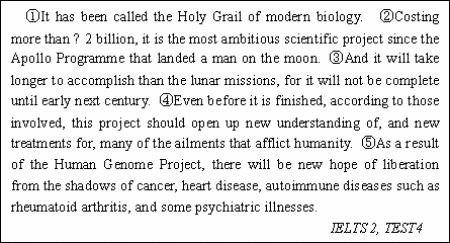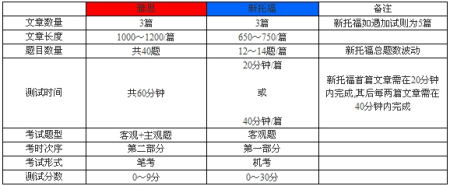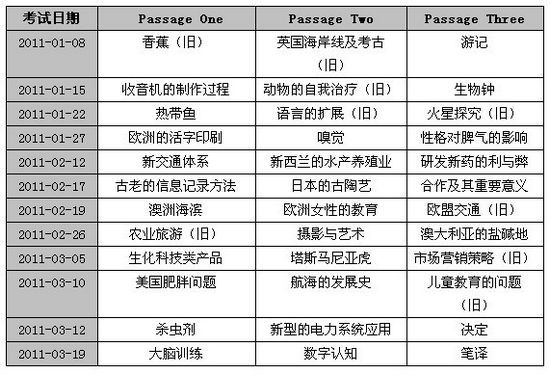来自:查字典高考网 2014-12-25
READING STRATEGIES AND SKILLS
This course will give you the opportunity to develop and practice reading strategies and skills which can be applied to all forms of IELTS tests. The strategies and skills you will practice are as follows:
1.Predicting
2.Skimming
3.Scanning
4.Detailed reading
5.Guessing unknown words
6.Understanding main ideas
7.Inferring
8.Understanding text organization
9.Assessing a writers purpose
10.Evaluating a writers attitude.
1 Predicting
Before you read a text in detail, it is possible to predict what information you may find in it. You will probably have some knowledge of the subject already, and you can use this knowledge to help you anticipate what a reading text contains. After looking at the title, for example, you can ask yourself what you know and do not know about the subject before you read the text. Or you can formulate questions that you would like to have answered by reading the text. These exercises will help you focus more effectively on the ideas in a text when you actually start reading.
To help you predict, you may also use skimming and scanning strategies as described below.
2 Skimming
Skimming involves reading quickly through a text to get an overall idea of its contents. Features of the text that can help you include the following:
(a) Title
(b) Sub-title(s)
(c) Details about the author
(d) Abstract
(e) Introductory paragraph
(f) First, second and last sentences of following paragraphs
(g) Concluding paragraph
A text may not contain all of these features - there may be no abstract, for example, and no sub-titles - but you can usually expect to find at least (a), (e), (f) and (g)。 Focusing on these will give you an understanding of the overall idea or gist of the text you are reading - in other words, a general understanding as opposed to a detailed reading.
Another term for this kind of reading is surveying. Surveying can be described as looking quickly through a book, chapter of a book, article from a journal, etc., to decide whether or not it is suitable for your purpose. To decide whether or not a text is suitable, especially if it is a book, you will also need to focus on the following features in addition to those mentioned above:
(a) Edition and date of publication
(b) Table of contents
(c) Foreword
(d) Introduction
(e) Index
3 Scanning
When you scan a text, again you look quickly through it. However, unlike skimming, scanning involves looking for specific words, scanning involves rapid reading for the specific rather than the general; for particular details rather than the overall idea. When you read a text, for example, you may want to find only a percentage figure or the dates of particular historical events instead of the main ideas. Scanning will help you find such information more efficiently.
4 Detailed reading
A second and third reading of a text will also focus on the secondary ideas and details which support, explain and develop the main ideas. This can be described as a more comprehensive reading. It involves a slower and more careful reading process. At this stage you can also try to guess the meaning of unfamiliar vocabulary.
5 Guessing unknown words
It is unlikely that you will understand 100 percent of the vocabulary in a text, especially at a first reading. Use first the context and then your own knowledge of the subject to help you guess the meaning of unknown words. At your first reading of a text it is usually best not to stop and consult your dictionary. This will interrupt your process of reading and understanding. often the meaning of unfamiliar words and phrases becomes clear as you continue to read through the text. The dictionary can be used at a later stage.
In using the context to help you guess unknown vocabulary, you can refer first to immediate context and then to the wider context in which a word is found. The immediate context is the sentence in which a word is found, and sometimes the sentences immediately before and after this. The wider context can include other sentences and even other paragraphs in a text. Both forms of context can often provide important information which help you guess the meaning of unfamiliar words.
6 Understanding main ideas
You will practice recognizing the main ideas contained within a text. In the process of skimming you will already have identified some of these main ideas. During a second and third reading you can recognize and understand them more fully. Each paragraph will usually contain one main idea. sometimes referred to as the paragraph topic.
The reading materials provide several exercises which help you identify and understand the main ideas in a text. Knowing the key points in a reading text is vital in assessing its importance and relevance for your needs. Understanding the main ideas will also lead you to an understanding of a writers organization.
7 Inferring
Sometimes a writer will suggest or express something indirectly in a text. In other words, a writer will imply something and leave it to the reader to infer or understand what is meant. When writers do this, they rely to some extent on the knowledge of their readers - knowledge of a subject or cultural knowledge, for example. Inferring a writers meaning is sometimes important in the process of understanding a reading text.
8 Understanding text organization
Writers structure, or organize, their writing in many different ways. Recognizing the way in which a text has been organized will help you understand its meaning more fully. A writer may want, for example, to outline a situation, discuss a problem and propose a solution. This will usually result in a particular pattern of organization. Or a writer may want to compare and contrast two ideas and will choose one of two basic structures commonly used to compare and contrast.
Another feature related to organization is a writers use of time. To give an account of events or describe a process, writers will often use a chronological order, in which events are recounted in thesgroupsin which they have occurred. Other writers will choose to organize an account of events in different ways, perhaps with repeated contrasts between past and present time.
9 Assessing a writers purpose
Once you understand the organization of a text, you can then recognize the writers purpose more clearly. The text organization a writer selects will partly depend upon his or her particular purpose. A writer may want to inform or persuade, and he or she will select a structure or pattern of organization according to this purpose.
A writer may also intend to do both of these things in a written text - to inform as will as persuade. In such cases it is often helpful to try to assess which of these purposes seems to be more important or dominant.
10 Evaluating a writers attitude.
Writers are not necessarily neutral or objective when they write, particularly if the are trying to persuade readers to agree with their opinions. It is important that you recognize what an authors attitude is in relation to the ideas or information being presented. This is because such attitudes can influence the ways in which information is presented. You will be looking at ways in which a writers attitude may be identified.
【雅思考试综合指导:实用阅读技巧】相关文章:
★ 雅思阅读高分技巧:Short answer questions
★ 雅思阅读解题技巧--True/False/NotGiven(下)
[标签:海外留学,考试,雅思]
 中学生雅思阅读快速提高的秘密
中学生雅思阅读快速提高的秘密  雅思vs托福 阅读异同大盘点对照表
雅思vs托福 阅读异同大盘点对照表  2011第一季度雅思阅读回顾与解析
2011第一季度雅思阅读回顾与解析 雅思阅读解题技巧--True/False/NotGiven(下)
雅思阅读解题技巧--True/False/NotGiven(上)
雅思阅读高分技巧:Short answer questions
崇文区2008-2009学年度第二学期高三统一练习(一)文综
崇文区2008-2009学年度第二学期高三统一练习(一)理综
崇文区2008-2009学年度第二学期高三统一练习(一) 数学理
崇文区2008-2009学年度第二学期高三统一练习(一) 英语
衍声高考琴行2019高本硕学生暑假音乐会 张俊瀚《陕北民歌主题变奏曲》《阿根廷舞曲》第三乐章
张雪峰高考志愿填报指南 第47集 高考志愿,令人头疼的数学系,才是专业万金油,毕业后机会多
广州早晨 2019 山西一高中班主任带学生骑行1800公里去上海
张雪峰高考志愿填报指南 第15集 高考填报志愿,想学电子信息类专业,推荐报这六所高校,不出错
高考阅卷名师给考生的高考作文密训课 第3集 高考作文审题实操方法精讲(一)
你高考成绩高吗?这道题目怎能成立?高难度奥数,能不能把你难住
北京新闻 2019 5.9万余北京考生今日高考 语文试题鼓励创造性阅读与表达
美术联考用纸上海考试模拟试卷纸高考统考纸 4k水粉纸素描纸 速写纸卡纸美术模拟测试试卷纸 美术考试专用纸